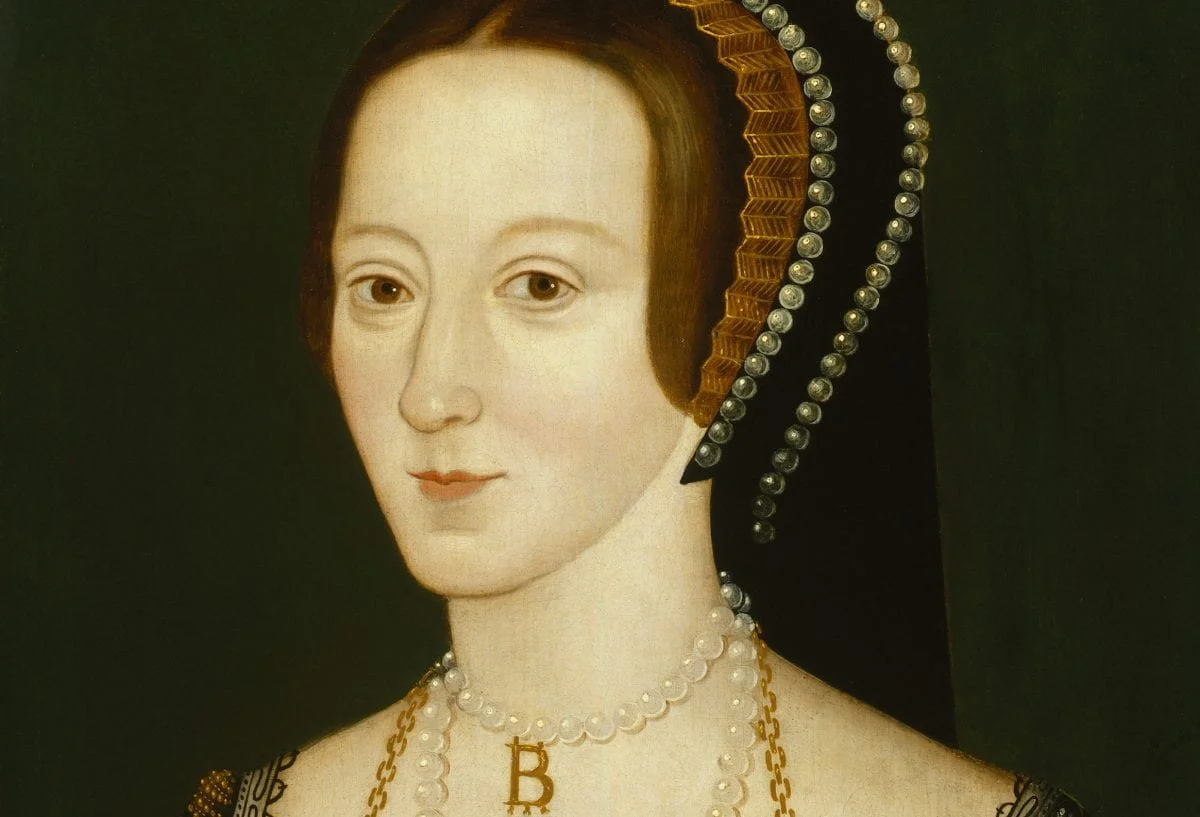Anne Boleyn, Queen of England and second wife of Henry VIII was executed within the grounds of the Tower of London. Her crime was a trumpeted up charge of adultery with two men of the court, and incest with her brother. The real reason for her execution was to remove Anne, who was an obstacle to Henry remarrying and having an heir.
After Henry set aside his first wife Catherine of Argon, he broke with the Church of Rome to allow him to marry Anne. Henry and Anne were married on the 25th January 1533 and on the 23rd of May 1533 Anne was crowned Queen of England.
While Anne gave Henry a daughter, the future Queen Elizabeth I, she failed to produce the male heir that Henry was desperate for. This failure caused Anne’s days as wife number two to be numbered. Henry by this time had identified a replacement, Jane Seymour, one of Anne’s ladies in waiting.
On April–May 1536, Henry had Anne investigated for high treason, adultery with two men of the court and incest with her brother. On the 2nd of May, she was arrested and sent to the Tower of London, where she was tried before a jury of her peers and found guilty on the 15th of May.

The punishment for this crime of adultery was to be burnt alive. However, Henry commuted the sentence to beheading by sword within the Tower of London.
On the 17th of May 1536 George Boleyn, Anne’s brother and the accused men were executed on Tower Hill. Two days later on the morning of the 19th of May, Anne accompanied by her female attendants, made her final walk from the Queen’s House and was led to the scaffold. There she met her death bravely without fear or regret.
Her speech on the scaffold to the small group invited to witness the execution was moving and short.
“Good Christian people, I am come hither to die, for according to the law, and by the law I am judged to die, and therefore I will speak nothing against it.
I am come hither to accuse no man, nor to speak anything of that, whereof I am accused and condemned to die, but I pray God save the king and send him long to reign over you, for a gentler nor a more merciful prince was there never: and to me he was ever a good, a gentle and sovereign lord. And if any person will meddle of my cause, I require them to judge the best.
And thus I take my leave of the world and of you all, and I heartily desire you all to pray for me. O Lord have mercy on me, to God I commend my soul.”
Just before the sword fell, she was heard to say her final words:
“To Jesus Christ I commend my soul; Lord Jesus receive my soul.”
While Anne’s execution was efficiently planned, the execution committee failed to organize a funeral, nor prove a proper coffin suited for her position.
According to an eyewitness, Anne’s ladies in waiting dealt with the disposal of her body, however it took some time before a coffin was found that was simply an empty arrow chest.
Anne was then buried in front of the High Altar, along with her brother within the Chapel of St Peter’s ad Vincula (St Peter in Chains) within the Tower precincts adjacent to the spot where the execution took place.
The Chapel Royal of St. Peter ad Vincula (“St. Peter in chains”) is the parish church of the Tower of London. It is situated within the Tower’s Inner Ward and dates from 1520. It is a Royal Peculiar. The name refers to St. Peter’s imprisonment under Herod Agrippa in Jerusalem.

In the middle of the 19th century during the reign of Queen Victoria, the entire Tower was “restored,” including the chapel which had fallen into a major state of disrepair. Unfortunately, much of the “restoration” was poorly done, resulting in some serious alteration and damage to the original fabric of the chapel and adjacent buildings.
Whilst on a tour of the restoration work in the chapel, Queen Victoria was told of the burials under the chapel floor and immediately ordered that the remains be exhumed and reburied. Only 30 of the burials under the floor were positively identified including the bodies of Anne, Jane Grey and Katherine Howard (Henry’s fifth wife also executed for adultery).
There has been much debate about the possibility of Anne being one of those exhumed. The main study was dependent on the opinion of Dr. Mouat, who was given the task to examine one particular body and the associated evidence:
- The body was found near George Boylan (identified by a lead burial plate on the body).
- The body was female and was in an elm arrow chest.
- It had been decapitated and the head was with the body.
- People executed by beheading had their heads placed on London Bridge, Annes was one of the very few who would have her head buried with her.
- Finally the location under the main High Altar matched the location of the eyewitness to the burial.
From this, he determined that the remains must indeed be that of Queen Anne.
The bones of several women, including but not limited to Anne Boleyn, Katherine Howard, and Jane Grey were then interred in a common grave or vault beneath the wall to the left of the High Altar.
There is a single marker plaque recording the names of the persons buried together. This also specifically states that they are interred together and several feet away from the marker. This means the marker is not over the exact spot of the burials.
I have spoken in detail to one of the experts of the Tower – now one of London’s most popular tourist attractions – about these burials and their location. He believes that the collected bones were deliberately placed in a spot that then made them inaccessible. The marker was then placed away from that spot, specifically to prevent future grave robbing by possible souvenir hunters or vandals, including 19th century personnel of the tower itself.
While public tours point out the individual spots where the three Queens of England are buried, it’s a ploy to keep the tourists happy is not actually correct. There is a myth that sometime after her execution her body was confiscated by family or friends and buried elsewhere. This has surfaced a number of times and was a very popular tale in the 19th Century. Even a highly respected writer of the status of Charles Dickens wrote a fictional account of the moving of Anne’s body from the Tower to her family tomb.
In 1842, a book called The Life of Anne Boleyn” by Agnes Strickland recorded the folklore in Anne’s local area in regards to her final resting place as follows;
“In Anne Boleyn’s native county, Norfolk, a curious tradition has been handed down from father to son for upwards of three centuries, which affirms that her remains were secretly removed from the Tower Church under the cover of darkness, and privately conveyed to Salle Church, the ancient burial place of the Boleyn’s; and there the body was interred at midnight, with the holy rites that were denied to her by her royal husband, at her first unhallowed funeral”
This myth continued to be popular and in 1858 in a book called “The Queens of England” by Francis Lancelott he says that;
“The remains of the unfortunate Anne Boleyn, covered with a sheet, were placed by her maids in an elm chest and immediately afterwards buried by the side of her fellow victims, in the chapel of the Tower, without singing or prayer; but her friends returned at midnight and disinterred them, and conveyed them away in secret, buried them in Salle Church, in Norfolk”
However the idea is highly controversial and one that cannot be backed with sufficient evidence. I would go further that the idea has no foundation for the following reasons. It would have been extremely hard to move the body without the knowledge of the authorities. I find it even harder to believe that Henry VIII would have granted permission for the relocation, such was his determination to wipe her name from history and keep her buried under his watchful eye.
Moreover I find it hard to believe that Anne’s family, who were busy distancing themselves from her in the last days, would then proceed to attempt to move her body.
Anne’s own father, Thomas Boleyn was one of the driving forces that over saw the conviction and execution of his daughter Anne, and his only son George to save his own skin. It would make no sense to endanger his life, titles and propriety to move Ann’s body to the family tomb. If he did, why did he also not move the body of his son George.
After Anne’s death, all mention of her name was kept to the bare minimum. If any one were to raise the issue regarding a new burial place for her, it would have only resulted in her name resurfacing, which would have brought great displeasure from Henry.
When we think of Anne Boleyn and her remains along with the other victims of that time, entombed in Chapel of St Peter’s ad Vincula we should consider the words of the Victorian historian, Lord Macaulay, who said;
“To this sad place were “carried, through successive ages, by the rude hands of gaolers, without one mourner following, the bleeding relics of men who had been the captains of armies, the leaders of parties, the oracles of senates, and the ornaments of courts.”
Written by Diarmaid Walshe
Header Image Credit : Bernard Gagnon







